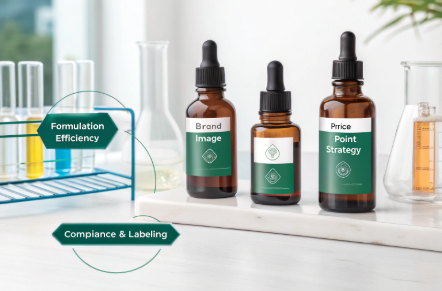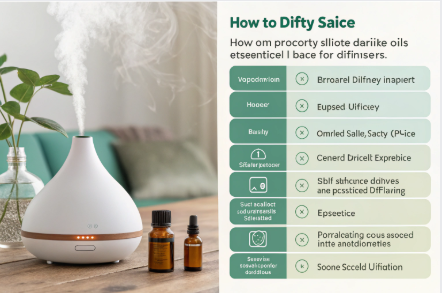Adding essential oils directly into your diffuser sounds simple—but without proper dilution, you might waste oils or even damage your device.
To dilute essential oils for diffusers safely, use proper ratios of water or carrier oils depending on the diffuser type and desired intensity. This ensures efficient diffusion and maximizes aromatherapeutic benefits.
If you're blending oils for home, spa, or retail use, getting the dilution right is essential to both safety and scent experience. Let’s walk through the guidelines step-by-step.
What is the 30 50 20 rule for essential oils?
Ever wondered how professional aromatherapists blend essential oils so beautifully?
The 30-50-20 rule is a blending guideline that breaks down a balanced aroma: 30% top notes, 50% middle notes, and 20% base notes.
Why It Works
-
Top notes (30%): First impression, evaporate quickly (e.g., lemon, peppermint)
-
Middle notes (50%): Heart of the blend, long-lasting (e.g., lavender, rosemary)
-
Base notes (20%): Ground the blend, slow to evaporate (e.g., cedarwood, patchouli)
Sample 10ml Blend Breakdown
| Note Type | % of Blend | Oil Type | Drops Approx. |
|---|---|---|---|
| Top | 30% | Bergamot | 9 |
| Middle | 50% | Geranium | 15 |
| Base | 20% | Sandalwood | 6 |
This ratio is especially useful for ultrasonic and nebulizing diffusers, where scent layering is noticeable. At PauPack, we often recommend our clients use this approach when creating essential oil kits for retail or gift packs.
What is the ratio of essential oils to water in a diffuser?
Adding too much oil can be overpowering or clog your machine. Less is often more.
The general ratio is 3–5 drops of essential oil per 100ml of water in most ultrasonic diffusers.
Safe Water-to-Oil Ratios
| Diffuser Capacity | Essential Oil Drops Recommended |
|---|---|
| 100ml | 3–5 drops |
| 200ml | 6–10 drops |
| 300ml | 9–12 drops |
| 500ml | 12–15 drops |
Adjust Based on:
-
Room size: Larger spaces need more drops.
-
Oil strength: Peppermint or eucalyptus can be strong—go easy.
-
Personal sensitivity: Start with fewer drops and build up.
At PauPack, we supply brands with dropper bottles that help control dosing accurately. Especially for 10ml or 15ml bottles, proper orifice reducers ensure just the right amount goes in.
What is the ratio of essential oils to carrier oils for diffuser?
Carrier oils in diffusers? Only in special cases—like reed diffusers or passive ceramic diffusers.
For reed diffusers, a safe blend is 20–30% essential oil to 70–80% carrier oil or diffuser base.
Recommended Blending for Reed Diffusers
| Total Volume | Essential Oils (30%) | Carrier Base (70%) |
|---|---|---|
| 100ml | 30ml | 70ml (e.g., DPG, jojoba) |
| 200ml | 60ml | 140ml |
Don’t use heavy oils like coconut or castor oil in reed diffusers. Instead, use light, thin oils such as fractionated coconut, or specialized diffuser base oils.
We at PauPack often work with home fragrance brands to develop custom essential oil blends pre-mixed with diffuser bases. Our packaging team ensures the bottle and cap are compatible with reed sticks to avoid leakage or absorption issues.
Can I mix essential oils with water for a diffuser?
Yes—but you need to know how to do it right, because oil and water don’t mix naturally.
Essential oils can be mixed with water in ultrasonic diffusers, but always add the oils after filling with water, and stir gently if needed.
Quick Best Practices
-
Use room temperature or distilled water to avoid residue.
-
Add essential oils last after filling to prevent over-concentration.
-
Shake gently if using spray mists or portable diffusers.
If you’re creating a mist spray product line, PauPack offers fine-mist spray bottles and frosted glass designs, starting at 30ml, with full private-label support. We test all oil-to-water ratios to prevent nozzle clogging or uneven dispersion.
Why Dilution Is Crucial for Safe and Effective Diffuser Use
Many assume essential oils are ready to use straight from the bottle—but direct use without dilution can cause problems.
Dilution is necessary to ensure even dispersion, avoid respiratory irritation, and protect your diffuser’s components from buildup or corrosion.
What Happens Without Proper Dilution?
-
Over-saturation of scent in the air
-
Clogging of diffuser ultrasonic plates
-
Skin sensitivity if mist touches the skin
-
Inconsistent aroma spread
Even in passive diffusers like reed sets or ceramic stones, using pure essential oil without a base can result in overwhelming concentration or rapid evaporation.
At PauPack, our diffuser bottle kits often come with dosage guidelines and volume indicators, especially helpful for new brands introducing essential oil sets.
How Different Types of Diffusers Affect Dilution Requirements
Not all diffusers work the same way—your dilution ratio should match your device type.
The dilution ratio depends on the diffuser type: ultrasonic, nebulizing, heat, or passive, each with different oil-to-liquid needs.
Common Diffuser Types and Their Requirements
| Diffuser Type | How It Works | Typical Ratio | Notes |
|---|---|---|---|
| Ultrasonic | Water + oil misted by vibration | 3–5 drops per 100ml | Most common for home use |
| Nebulizing | Pure oil dispersed as fine mist | No dilution | Use only pure essential oils |
| Heat | Heat evaporates oil into air | 5–10 drops | Quick scent release, short-lived |
| Passive (Reed) | Absorbs and diffuses oil | 20–30% in base liquid | Needs carrier like DPG or alcohol |
Special Considerations
-
Nebulizers should not be filled with blends containing carrier oils or water.
-
Ultrasonic diffusers are delicate—excess oil clogs or damages plates.
We advise PauPack clients to label bottles clearly for diffuser compatibility—especially for multipurpose blends sold both as massage oil and aromatic blends.
What Tools and Accessories Can Help with Accurate Dilution?
Accurate dilution isn’t just about math—it’s about using the right tools for repeatable results.
Use droppers, measuring spoons, graduated pipettes, and proper reducer caps to ensure consistent essential oil dilution.
Essential Dilution Tools
| Tool | Use Case | Benefit |
|---|---|---|
| Glass Droppers | Accurate drop-by-drop control | Essential for 5ml–15ml bottle use |
| Orifice Reducers | Built-in drop limiter | Prevents spills or overuse |
| Graduated Pipettes | Precise ml measurement | Useful for 30ml+ bottles |
| Mini Funnels | Mixing blends without waste | Cleaner production |
| Label Stickers | Mark dilution levels or usage | Helpful for subscription models |
PauPack offers dropper bottles in all standard essential oil sizes with leak-proof inserts and reducer options—ideal for B2B and boutique brands alike.
How to Adjust Essential Oil Concentration for Children and Pets
Essential oils are powerful—and for little lungs or sensitive animals, proper dilution becomes even more critical.
Reduce essential oil concentration drastically for children, babies, or pets to avoid adverse reactions like irritation or toxicity.
Recommended Dilution Ratios
| User Group | Diffuser Oil Concentration |
|---|---|
| Adults | 3–5 drops per 100ml water |
| Children (2–12) | 1–2 drops per 100ml water |
| Babies (<2) | 1 drop or none; use hydrosols only |
| Pets (dogs) | 1–2 drops per 200ml water |
| Cats | Avoid essential oils entirely |
Safe Oils by Age
-
For kids: Lavender, chamomile, sweet orange
-
Avoid for kids: Peppermint, eucalyptus (risk of respiratory stress)
-
For pets: Frankincense, cedarwood (dogs only)
-
Avoid for pets: Tea tree, citrus (especially for cats)
PauPack offers amber and cobalt glass bottles with safety labeling options for age-appropriate usage, helping brands build trust with family-focused customers.
What Are the Best Carrier Liquids to Use in DIY Diffuser Blends?
Water isn’t always the right base—especially in reed or heat diffusers where oils evaporate quickly.
Carrier liquids help essential oils disperse more evenly, evaporate at a consistent rate, and prevent over-saturation in DIY or passive diffuser systems.
Recommended Carriers by Use
| Base Type | Best Use | Pros | Cons |
|---|---|---|---|
| Dipropylene Glycol (DPG) | Reed diffusers | Slow evaporation, clear | Synthetic, not for skincare |
| Fractionated Coconut Oil | Ceramic/pottery diffusers | Light, odorless | Not water-compatible |
| Alcohol (Perfumers) | Spray diffusers | Quick evaporation | Can irritate skin/sensitive users |
| Glycerin (small amount) | Blends with water | Improves consistency | Sticky if overused |
We support custom formulation and bottle filling services at PauPack—ideal if you’re creating reed diffuser kits or multi-use room sprays.
Conclusion
From understanding device types to using the right base and tools, diluting essential oils for diffusers is both science and art. Master it, and your scent becomes your signature.














